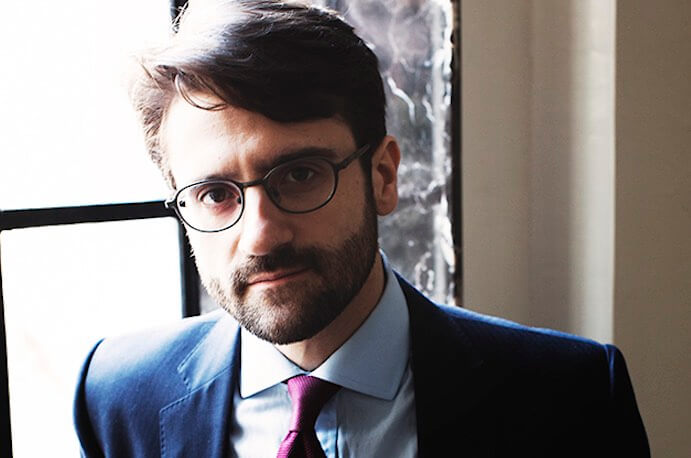Caroline Shaw has made a noticeable and meaningful impact on Vancouver’s artistic scene ever since becoming Music on Main‘s Composer in Residence in 2014. Those who attended One Night Stand on Tuesday, May 10, 2016 would know exactly what I mean–after all, the Vancouver Symphony Orchestra hosted James Ehnes’ recital on the same night, yet Shaw was greeted enthusiastically by a sold out crowd at The Fox Cabaret. It’s no wonder Shaw has found the kind of success she has had in recent years: her music, much like the composer herself, is compelling yet entirely devoid of pretense. She arrived at the venue in yellow sneakers, apologized for misplacing her formal footwear, then swiftly set off to host and perform in the evening’s program alongside pianist David Kaplan and the Emily Carr String Quartet.
The concert began with a piece for string quartet entitled Valencia (2012) which, according to notes on Shaw’s website, pays homage to the namesake orange and its natural construct of vesicles and rind. Hearing the composition with this knowledge in mind made for a delightful listening experience because the undulating harmonics and blips of pizzicato really did seem to embody the qualities of a citrus fruit through sound. This sense of playfulness carried over into David Kaplan’s interpretation of Mit guten Humor, un poco lol ma con serioso vibes (2014), a clever translation of Schumann’s Davidsbündlertänze, Op. 6: XVI Mit gutem Humor (1837) into Shaw’s musical lexicon. The miniature movement was composed specifically for Kaplan–an old classmate of Shaw’s from Yale–who played it with such rhythmic and emotional sensitivity that the piece seemed to emerge from beneath his fingers. Shaw then appeared off-stage with her violin to play a short improvisational segue into her next composition, Gustave Le Gray (2012).

David Kaplan–Photo by Samantha West
Gustave Le Gray was a 19th century French photographer who mastered the technique of developing seascape photographs by using separate negatives for the ocean and the sky. Inspired by his experiments with light, layers, and time, Shaw decided to develop her own musical portrait of Mazurka in A Minor, Op. 17, No. 4, a piece written by Chopin not long after he became a refugee in France from Poland. Gustave Le Gray captures the melancholic nature of its source material with exquisite truth and clarity, yet the repetitive chords seem to be obscuring a deeper sense of frustration, as if the music is trying to summon a stubborn memory from within. Under Kaplan’s tutelage, Gustave Le Gray sounded remarkably accurate to Shaw’s marking on the score: “like a photograph slowly developing on waxed paper.” The haunting performance was followed by yet another improvisation, this time with Shaw using a loop pedal and accompanied by the captivating motions of dancer Vanessa Goodman.
After a brief intermission, the Emily Carr String Quartet made their way back onto the stage with Entr’acte (2011). Shaw wrote the piece after hearing the Brentano Quartet play Haydn’s String Quartet in D minor, Op. 76, No. 2, “with their spare and soulful shift to the D-flat major trio in the minuet.” An unwavering commitment to Shaw’s idiosyncrasies and a knack for comedic timing helped to define the Emily Carr String Quartet’s stellar performance. Their cleverly placed pauses, quiet swipes of their bows across the strings, and little instrumental sighs near the end of Entr’acte elicited plenty of giggles from the audience–not an easy feat for a string quartet to pull off, yet they managed to do so with the confidence of a seasoned stand-up comedian.

Emily Carr String Quartet
The final works of the night took a turn towards the spiritual, first with Shaw on the violin for In manus tuas (2009), and second with the Emily Carr String Quartet playing in support of Shaw on vocals for By and By (2010). In manus tuas takes a 16th century motet by Thomas Tallis and breaks up its harmonies into a set of sparse yet intensely passionate arpeggiated chords. The piece is meant to be experienced in a Neo-Gothic church lit only by candles and filled with the scent of incense, yet The Fox Cabaret felt just as appropriate for the occasion. This helped to set the tone for By and By, a collection of three re-imagined songs – Stars in my Crown, Angel Band, I’ll Fly Away–using lyrics from old bluegrass and gospel hymns of the same titles. Shaw’s singing simply radiated with joy; it was a joy to behold in return.
Vancouver has been fortunate to host Caroline Shaw for the past two years, and the city owes a debt of gratitude to Music on Main for making this residency possible. Be sure to give their Composer Essay Project a read for more insights on the creative process behind Shaw’s work, among other contemporary composers.





















